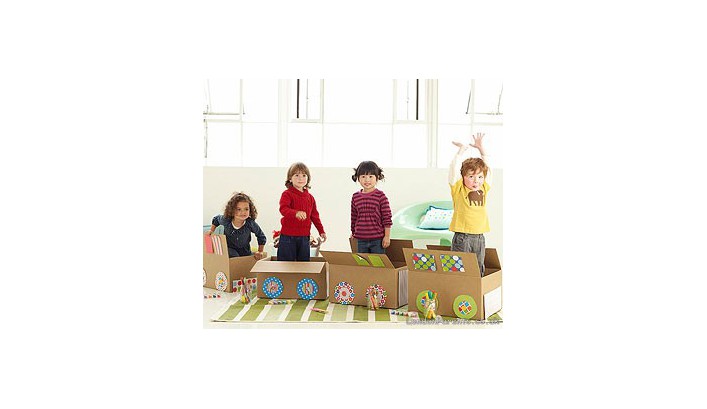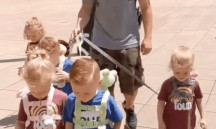Article Categories
News
-
20 July
-
04 November
-
10 July
-
12 June
-
05 June
-
24 September
-
19 September
-
10 May
-
26 April
Website Categories

Build-a-Train
How to play: You'll need several cardboard boxes large enough for a kid to sit inside. Put out a variety of art supplies -- markers, stickers, construction paper, glue -- and tell each child to turn his or her box into a train car. Once they've decorated the outside of their box with wheels, windows, and whatever else they can think of, help them arrange the cars one behind the other, then hop aboard for an imaginary choo-choo ride.
What it teaches: Perseverance. Games that require team prep work give kids a sense of accomplishment, says clinical psychologist Sandra McLeod Humphrey, author of Hot Issues, Cool Choices: Facing Bullies, Peer Pressure, Popularity, and Put-Downs. The positive payoff introduces children to the good feeling they get when they achieve their hard-earned goals.
Parent tip: Be prepared to hang on to those boxes; the kids will want to get together and hit the track again and again.
The Cheer-Up Game
How to play: On large squares of paper, draw a series of faces with different unhappy expressions -- sad, angry, scared, sick (at least one for every child in the game). Put the papers in a basket and ask kids to take turns choosing a face then acting out the feeling shown. For example, a "sad" child might pretend to cry. It's the job of the other players to help her feel better. First, they should ask questions: "Why are you sad? How can I help?" After the "upset" child gives her explanation -- "My friend was mean to me" -- the other kids role-play solutions. They may give hugs, say "I'm sorry," or offer to fix a snack.
What it teaches: Empathy. This is the "core" virtue, notes Parents advisor Michele Borba, EdD, author of 12 Simple Secrets Real Moms Know. "Until children know how it feels to have their feelings hurt, they won't understand why it's important to treat others with respect and kindness," she says.
Parent tip: Have a variety of props on hand for this imagination-powered game: plastic food, stuffed animals, a doctor's kit. The more options available, the more creative kids will be about ways to help out, from putting a bandage on the injured kid's boo-boo to baking pretend cookies for a bummed-out buddy.
The Hot or Cold Game
How to play: Choose one child to be the "Finder." Send him out of the room while the rest of the players hide an object, like a red ball, somewhere in the room. Ask the Finder to come back and look for the ball, while the other players shout out hints: "You're getting hotter" or "you're getting colder." Play until the object is found, then give everyone a turn as the Finder.
What it teaches: Cooperation. This game puts the emphasis on encouraging other players, not competing against them, so preschoolers learn to help each other out in a fun setting.
Parent tip: Try asking kids to speak louder or softer depending on how close or far away the Finder is from the hidden object.
"I Spy"
How to play: Take turns spotting nearby objects and describing them: "I spy with my little eye something that is green...." The other players try to guess what the object is: "A tree!" "Dad's shirt!" Whoever guesses right gets to be the next "spy."
What it teaches: Patience. "Patience is all about waiting," explains Dr. Borba. Any game that forces kids to listen politely while other players have their turn drives this lesson home.
Parent tip: This is a great one to try in situations where kids are likely to get bored and edgy, such as on a long airplane flight.
"Mother, May I?"
How to play: Line up the players facing you, about 10 feet away. Give commands to one kid at a time: "Sarah, take one hop forward." If Sarah responds, "Mother, may I?" you can say either "Yes, you may" or "No, you may not." If your reply is "yes," make sure that Sarah says "Thank you" before she goes. Anyone who forgets her manners or makes a move without permission is sent back to the starting line. Keep playing until one child reaches Mother. Give each kid a chance to be Mother.
What it teaches: Respect. You can't just tell kids to be respectful, you have to teach them the skills. "This game reinforces courtesy, which is a big part of respect," says Dr. Borba.
Parent tip: To avoid frustration over misunderstood consequences ("I didn't know I had to say thank you!"), make the rules of the game perfectly clear before you get started.
To Tell the Truth
How to play: Gather the family in a favorite spot and give every player a chance to finish the sentence: "I was scared when...." Mom and Dad can get the ball rolling by telling their own stories ("I was scared when Josh hid at the grocery store and I couldn't find him"). After everyone's had a turn, repeat the game using other emotions like "happy" or "surprised."
What it teaches: Honesty. When you give kids the go-ahead to talk about their feelings, positive or negative, you help them feel safe to tell the truth. "Children learn values best from watching and listening to Mom and Dad," says Bob Sornson, PhD, founder of the Early Learning Foundation. "If you talk openly and if you are supportive of family members in front of the kids, you set a healthy example of how to act with others."
Parent tip: Use kids' stories as a springboard for further discussion: "Do you still think thunderstorms are scary? What helps you feel brave?" "Can you remember other happy times?"
Balloon Bash
How to play: Find an open area where your kids won't bump into furniture. Then give each child two balloons (don't try this with kids under 3, since balloons are a choking and suffocation hazard). When you say "go," they must team up to keep the balloons in the air for a set time (start with 30 seconds). You can also have them try bopping the balloons with just one silly part of their body, such as their nose or their pinkie fingers.
What it teaches: Teamwork beats arguing.
Why it works: Your children will see the value of working together toward a common goal. Remind them of this lesson the next time you ask them to clean their room or set the table.
Treasure Hunt
How to play: Make a certificate good for an extra story, a back rub, or your child's favorite breakfast. Hide the slip of paper in her room, then let her look for it after she's brushed her teeth. If she's having trouble, give hints, such as, "You're getting warmer."
What it teaches: Bedtime cooperation.
Why it works: Bedtime becomes fun for kids when they get extra time with Mommy and Daddy and have little bonuses to look forward to.
Related articles
Parenting is no easy task, and for Jordan and Briana Driskell, raising their quintuplets—Zoey, Dakota, Hollyn, Asher, and Gavin&mdash...
Read moreFocus on back to school - include a free...
Emma WallaceThe summer holidays are drawing to a close and September sees pupils heading back to the classroom. Alongside buying new uniform and statio...
Read moreA Starbucks employee went viral after sharing a video where they broke down in tears due to being scheduled for an eight-hour shift. ...
Read more0 comments
No messages yet




